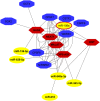Non-coding RNAs in the Ovarian Follicle
- PMID: 28553318
- PMCID: PMC5427069
- DOI: 10.3389/fgene.2017.00057
Non-coding RNAs in the Ovarian Follicle
Abstract
The mammalian ovarian follicle is the complex reproductive unit comprising germ cell, somatic cells (Cumulus and Granulosa cells), and follicular fluid (FF): paracrine communication among the different cell types through FF ensures the development of a mature oocyte ready for fertilization. This paper is focused on non-coding RNAs in ovarian follicles and their predicted role in the pathways involved in oocyte growth and maturation. We determined the expression profiles of microRNAs in human oocytes and FF by high-throughput analysis and identified 267 microRNAs in FF and 176 in oocytes. Most of these were FF microRNAs, while 9 were oocyte specific. By bioinformatic analysis, independently performed on FF and oocyte microRNAs, we identified the most significant Biological Processes and the pathways regulated by their validated targets. We found many pathways shared between the two compartments and some specific for oocyte microRNAs. Moreover, we found 41 long non-coding RNAs able to interact with oocyte microRNAs and potentially involved in the regulation of folliculogenesis. These data are important in basic reproductive research and could also be useful for clinical applications. In fact, the characterization of non-coding RNAs in ovarian follicles could improve reproductive disease diagnosis, provide biomarkers of oocyte quality in Assisted Reproductive Treatment, and allow the development of therapies for infertility disorders.
Keywords: follicular fluid; human oocyte; lncRNAs; microRNAs; ovarian follicle.
Figures




Similar articles
-
Anti-Müllerian hormone is highly expressed and secreted from cumulus granulosa cells of stimulated preovulatory immature and atretic oocytes.Reprod Biomed Online. 2012 May;24(5):540-6. doi: 10.1016/j.rbmo.2012.01.023. Epub 2012 Jan 31. Reprod Biomed Online. 2012. PMID: 22421733
-
C-type natriuretic peptide signaling in human follicular environment and its relation with oocyte maturation.Mol Cell Endocrinol. 2019 Jul 15;492:110444. doi: 10.1016/j.mce.2019.05.003. Epub 2019 May 7. Mol Cell Endocrinol. 2019. PMID: 31075302
-
Identification of Novel MicroRNAs and Characterization of MicroRNA Expression Profiles in Zebrafish Ovarian Follicular Cells.Front Endocrinol (Lausanne). 2019 Jul 31;10:518. doi: 10.3389/fendo.2019.00518. eCollection 2019. Front Endocrinol (Lausanne). 2019. PMID: 31417497 Free PMC article.
-
Oocyte-somatic cell interactions in the human ovary-novel role of bone morphogenetic proteins and growth differentiation factors.Hum Reprod Update. 2016 Dec;23(1):1-18. doi: 10.1093/humupd/dmw039. Epub 2016 Oct 26. Hum Reprod Update. 2016. PMID: 27797914 Free PMC article. Review.
-
Exosome-mediated communication in the ovarian follicle.J Assist Reprod Genet. 2016 Mar;33(3):303-311. doi: 10.1007/s10815-016-0657-9. Epub 2016 Jan 27. J Assist Reprod Genet. 2016. PMID: 26814471 Free PMC article. Review.
Cited by
-
Besides Pathology: Long Non-Coding RNA in Cell and Tissue Homeostasis.Noncoding RNA. 2018 Jan 30;4(1):3. doi: 10.3390/ncrna4010003. Noncoding RNA. 2018. PMID: 29657300 Free PMC article. Review.
-
Regulatory role of long non-coding RNAs during reproductive disease.Am J Transl Res. 2018 Jan 15;10(1):1-12. eCollection 2018. Am J Transl Res. 2018. PMID: 29422989 Free PMC article. Review.
-
Predictive modeling of oocyte maternal mRNA features for five mammalian species reveals potential shared and species-restricted regulators during maturation.Physiol Genomics. 2024 Jan 1;56(1):9-31. doi: 10.1152/physiolgenomics.00048.2023. Epub 2023 Oct 16. Physiol Genomics. 2024. PMID: 37842744 Free PMC article.
-
Hypothalamus Transcriptome Reveals Key lncRNAs and mRNAs Associated with Fecundity in Goats.Animals (Basel). 2025 Mar 6;15(5):754. doi: 10.3390/ani15050754. Animals (Basel). 2025. PMID: 40076037 Free PMC article.
-
Building a Human Ovarian Antioxidant ceRNA Network "OvAnOx": A Bioinformatic Perspective for Research on Redox-Related Ovarian Functions and Dysfunctions.Antioxidants (Basel). 2024 Sep 12;13(9):1101. doi: 10.3390/antiox13091101. Antioxidants (Basel). 2024. PMID: 39334761 Free PMC article. Review.
References
-
- Bartel D. P. (2004). MicroRNAs: genomics, biogenesis, mechanism, and function. Cell 116 281–297. - PubMed
LinkOut - more resources
Full Text Sources
Other Literature Sources
Molecular Biology Databases

